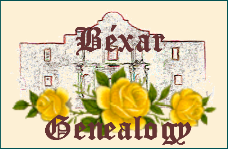





























Search

Search




Download the latest version of Adobe Reader click on the icon below:


© 2002- 2012, Steve Gibson, Bexar Genealogy, All Rights Reserved



Cornelius Van Ness and his brother George Van Ness came to San Antonio in 1837 and 1838 respectively where they both practiced Law. Cornelius represented Bexar County four times in the congress of the republic, where he was a member of the committee on Indian affairs. He died in San Antonio on May 2, 1842. In 1841, George was appointed as a member of the commission to represent the Republic of Texas on the Texan Santa Fe Expedition to secure the Republic’s claims to parts of New Mexico. Among the men on the Texan Santa Fe Expedition were merchants that were promised transportation and protection of their merchandise during the expedition, as well as commissioners William G. Cooke, Richard F. Brenham, José Antonio Navarro, and George Van Ness.
San Antonio was seized twice in the Mexican invasions of 1842, and the population was reduced to about 800 in 1846. The city council employed John James, the deputy county surveyor, to reestablished the boundaries of the original grant from the king of Spain to the city of San Antonio after Mexican general Adrián Woll's forces captured the city in 1842. James had read the original Spanish grant which delineated the area of San Antonio, and knew it from memory. He accordingly began to survey the city anew and reestablish the old property lines. [James Descendants Report]
From the time of it founding in 1718, as a fort to protect the Mission San Antonio de Valero, until the time of The Republic of Texas, San Antonio struggled to survive while under Spanish and Mexican rule. In 1834, the population of San Antonio numbered only 2,400 or less than half of that of the previous quarter century.
During the Texas Revolution, San Antonio was the site of several battles, including the Siege of Bexar and the Battle of the Alamo. While many of the men from San Antonio were away with Sam Houston’s army, many of their families fled and abandoned the city in an effort to escape Santa Anna’s army, joining the famous “Runaway Scrape.” The news of the Alamo's fall and the Goliad Massacre of James Fannin's men created a panic among Texas settlers who began to leave everything and make their way east towards safety. The flight continued until news came of General Santa Anna’s defeat at the battle of San Jacinto.
After the defeat of Santa Ana’s army at San Jacinto, Juan Seguin was put in charge of a provisional government in San Antonio. On June 5, 1837, the city of Bexar was incorporated by the Texas Congress, and then on December 14, of the same year, it was reincorporated as the City of San Antonio. A failed attempt to negotiate the release of captives held by Comanche Indians resulted in yet another battle in the streets of the town, the Council House Fight of 1840.
In the city's first municipal election in 1837, John W. Smith was named the first mayor of San Antonio under the Republic of Texas. Manuel Martínez, Francisco Bustillos, Gabriel Arreola, Rafael Herrera, Francisco Antonio Ruiz, Ramón Treviño, Pedro Morales, and Francisco Granado were elected to the city council. Likewise, José Eugenio Navarro was elected treasurer, Manuel Pérez secretary, and Vicente de la Garza collector.
John William Smith, also known as "El Colorado" or "redhead" came to San Antonio from Missouri in 1826. He was a scout and guide and was the last messenger to leave the Alamo. The fact that he was also chosen to be the first mayor attested to his popularity among the Spanish-speaking people of San Antonio. After divorcing his first wife, Harriet Stone, he married Canary Island descendant María de Jesús Curbelo and they had six children. [JW Smith Descendants Report], [Tobin Descendants Report]
Erastus, or Deaf Smith, known as “El Sordo”, came to San Antonio in 1821. In 1822 he married Guadlupe Ruiz, they had four children, three of whom, all daughters, survived to adulthood. He fought at the Grass Fight and the Battle of San Jacinto. After the war, Deaf Smith led a company of Texas Rangers. Their oldest daughter Susan Smith married Nathaniel Fisk in 1839. After her death, Fisk married her sister Simona Smith on 1 Aug 1849. Fisk served in the Army of Texas from 1836 to 1837. [Smith Descendants Report]
Philip Dimmitt a pioneer Texas trader and merchant and major figure in the Texas Revolution, was born in Kentucky, about 1801 and traveled to Texas about 1823 with a letter of introduction to Stephen F. Austin. He settled in La Villita at Bexar and for several years and was commissary contractor to the Mexican garrison there. He married María Luisa Lazo, whose father was a De León colonist and kinsman of Martín De León, and by marriage received a three-league headright in De León's colony.
Another aspect of the change taking place in San Antonio related to the character of it population. The number of Anglo-Americans began to increase while the number of Tejanos decreased. The availability of free land acted as a magnet to attract large numbers of Anglos to San Antonio, many of whom where unsavory to say the least. But, men of character and leadership also came to San Antonio many with their families. Almost all, contributing to the growth and development of the city. [Dimmitt Descendants Report]
One such man was Samuel A. Maverick, a man who had been in San Antonio during the siege of 1835, was a signer of the Texas Declaration of Independence before he returned to Alabama. He returned to Texas with his wife and young son in July of 1838. Samuel married Mary Ann Adams in Tuscaloosa County, Alabama and after the birth of their first son, Samuel A Maverick, Jr, moved to San Antonio. Samuel was a large land holder with several ranches between San Antonio and Victoria, Texas. He refused to brand his cattle which led to the use of the term "maverick" to describe unbranded cattle. He served as the city's mayor in 1839 and was arrested an imprisoned at the Perote Prison by Mexican General Adrián Woll. [Maverick Descendants Report]



The Fall of the Alamo
by
Robert Jenkins Onderdonk
depicts Davy Crockett in a charge at the Mexican troops who have breached the walls of the mission.

